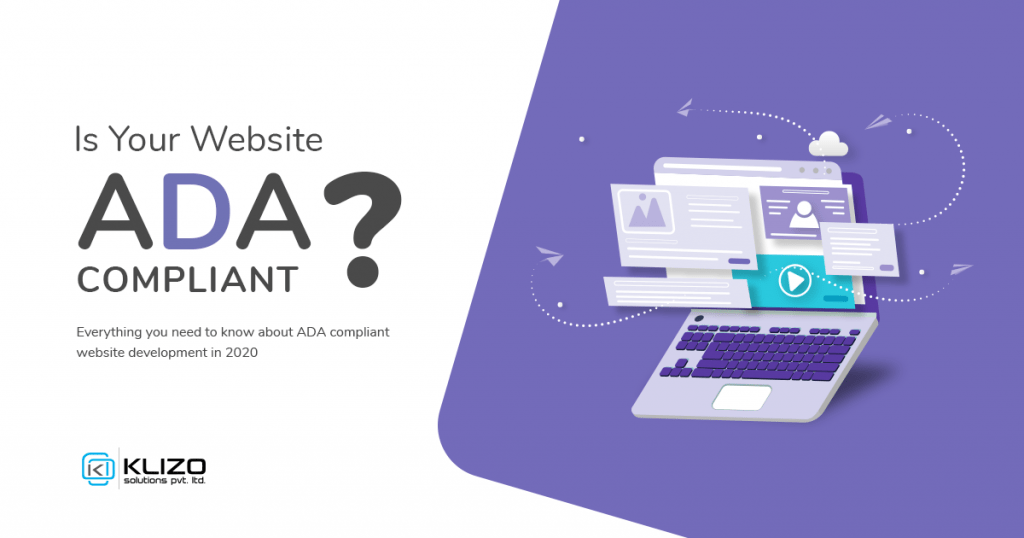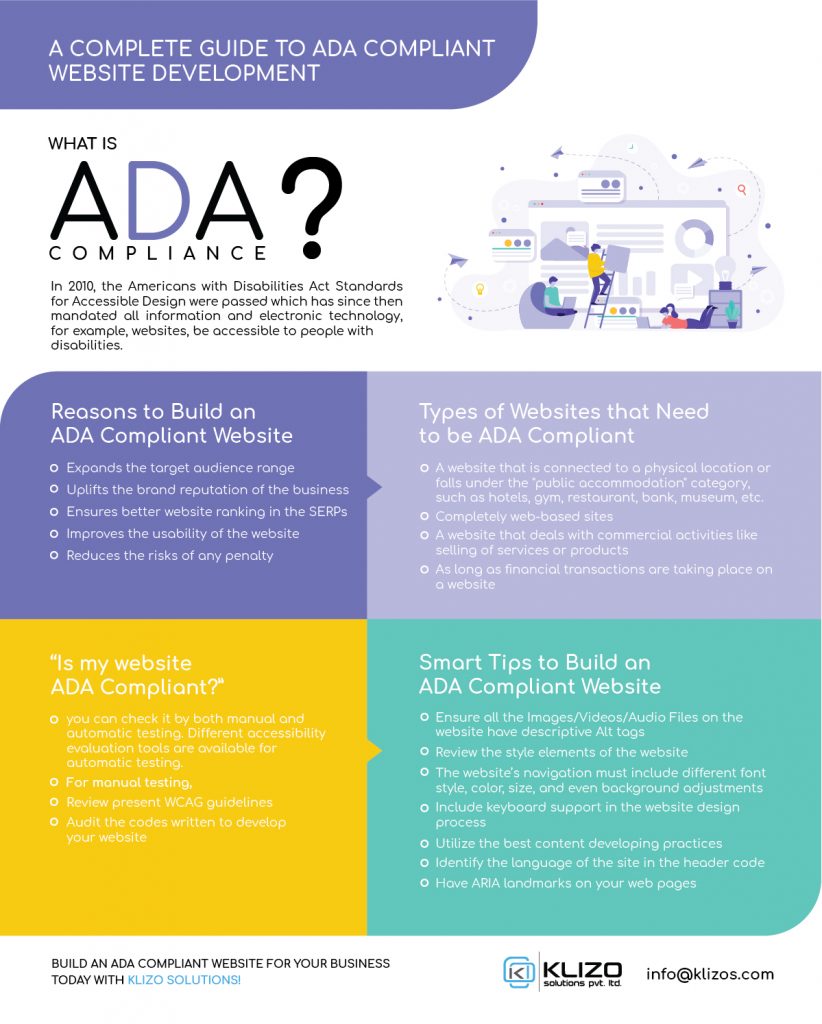


Did you know that the ADA Compliant website lawsuit was filed against world-famous American pop-singer Beyoncé?
Even popular restaurant businesses like Domino’s Pizza and Burger King were sued for not making their websites fully accessible by visually impaired individuals!
Well, now the question is – “Is your website ADA compliant?“
Have you ever thought about contacting an ADA compliant website developer to make your website ADA accessible?
Well, if not, then it’s high time you consider doing so as it has a more serious role to play in determining the overall success of your website than you might have thought.
Believe it or not, but more than 70% of potential customers leave a website if it is not accessible enough. To ensure that your customers stay happy with your website, you must create a website that is easy to use for everyone i.e. improve the web accessibility for your site. And by everyone, we mean even the visitors with disabilities.
Here, in this article, we have gathered all the information that you might want to know about ADA and why it is crucial to opt for an ADA compliant website developer right away and make your website accessible to everyone.
If you are in a hurry, take a quick glance at the following infographic on ADA compliant website.

Developed in 1990, ADA stands for the Americans with Disabilities Act. The objective of implementing this act is to ensure access to the same opportunities for people with disabilities as everyone else.
This act was applied to make sure that the buildings of any business that serve the public have the necessary facilities to accommodate people with disabilities.
In 2010, the Americans with Disabilities Act Standards for Accessible Design were passed which has since then mandated all information and electronic technology, for example, websites, be accessible to people with disabilities.
Now, websites being the digital presence of businesses these days, and almost every business has a website to market their brand, product, and services better, ADA compliance applies to both websites and business mobile applications.
Having an ADA compliant website means people with disabilities like visual, hearing or physical impairments can access your website as easily as others.
The objective of implementing this act for websites or mobile apps is to remove any barrier that may inhibit a person with a disability from accessing the goods or services provided by a business.
While creating a website often people wonder whether they should pay attention to its ADA compliance or not. If you are one of them, then trust me, there are plenty of solid reasons to contact an ADA compliant website designer to build a website that follows ADA compliance.
Let’s take a detailed look at the five essential reasons for creating an easily accessible website.
When you don’t make your website ADA-Compliant, it makes part of your target audiences who suffer from disabilities feel excluded. And considering the rapidly growing online competition, alienating even a slight part of your target audience can prove to be fatal for your business success.
You never know when someone with a disability finds your website interesting. Taking the help of an ADA compliant website builder and creating a website that is ADA accessible, means developing a website that is accessible and viewable for everyone.
Having ADA compliance can make everyone feel welcome on your business website as it will allow them to access every webpage the way they like or find the best suitable.
When you hire an ADA compliant website builder to make your website ADA accessible, it creates a positive reputation for your brand or business.
Wondering how? Well, it simply shows your audience that you care about them enough to cater to their exact requirements.
Imagine the websites of your competitors are non-compliant to ADA. Therefore when someone with a disability will visit their website looking for information about their products, they will feel discouraged from browsing their websites.
At the same time, your website being ADA compliant will successfully accommodate their needs. As a result, they will happily browse through your website and may opt for your services or products too!
This positive experience of users on your website not only puts your business in a positive light but also makes your business more popular as the happy customers are likely to pass their positive browsing experience to others.
The more ADA accessible your website is, the better your search engine optimization ranking gets.
Search engines are crawling web pages with more human intention than ever now. And screen readers, too, crawl your pages just the way search engines do. So, a tremendously accessible web page naturally appeals to the users as well as to the screen readers and the search engines more than a webpage that is not at all accessible.
When you incorporate alternative image texts, meta-tagging, video transcripts, etc. on your website it not only meets the WCAG or Website Content Accessibility Guidelines but also makes your website more accessible to the audience.
Just like the users, with easily accessible information search engines also gets a better understanding of what your website contains. And when search engines understand your website better, your website gets more appropriately ranked on the SERPs.
Yes, ADA compliance plays an important role in improving your website SEO ranking. So next time someone asks you what does ADA compliant mean for websites, you’ll know what to tell.
User experience is a vital part of any website. The better experience users have while browsing your website, the higher is the chance for your website to achieve success.
Failing to provide a positive experience to users simply means poor lead generation or no leads at all. But what if you can increase the usability of your site just by being ADA compliant?
Ask again what does ADA compliant mean for websites? And this time we want you to know that meeting ADA and WCAG guidelines simply make your website more easily navigable and operable for everyone, whether disabled or not.
Creating easy to comprehend as well as easy to access webpages means providing valuable information to the users and covering all the bases where they might face difficulties. Once your users know that they can easily find any content they are looking for on your website, more and more leads are bound to convert.
Did you know that well-known media personality and beauty industry entrepreneur Kylie Jenner’s business was sued for not having an ADA compliant website?
Well, if you don’t want your business website to end up in an ADA Compliant website lawsuit battle and bear the legal costs of not being compliant with ADA, it will be wise to make the necessary changes to make it ADA compliant.
Though there is no mention of websites in the ADA text, since, back then in the 90s websites weren’t such a thing. But presently, almost every business has a website, making that website accessible to anyone and everyone is of priority.
According to WCAG 2.1 (Web Content Accessibility Guidelines), which was published in 2018, every website needs to be compliant to at least Grade-A, where Grade-AAA is the highest.
All websites can be and should be ADA compliant.
If you’re willing to know which websites are legally obliged to abide by the ADA guidelines, then here are the ADA compliant website examples:
Now after knowing the importance of ADA compliance, you must be asking yourself “Is my website ADA compliant”!
Well, to find out whether your website is ADA-compliant or not, both manual and automatic testing can be done.
While checking the ADA compliance of your website automatically can be done using various accessibility evaluation tools; for checking it manually, below are the steps:
No, there are no fixed guidelines about how to make a website ADA compliant. Well, there are certain smart tips that can make your website easily usable for persons with disabilities.
Let’s take a quick look at those tips here:
Unsure how to make the website ADA compliant, Klizo Solutions has all the assistance you might need to develop an ADA Compliant effective website.
From finding out whether your website is presently an ADA compliant or not or making it ADA compliant, our team of expert web developers can help you out with everything. Starting from the very first brainstorming session of perceiving the idea of ideal web design to ensuring the success of your marketing campaigns, we offer various web development and management services.
The techniques and practices that we implement not only provide your website with maximum digital accessibility but better equip it to comply with both WCAG and ADA guidelines. Our AAA-grade and ADA compliant website designs deliver you such websites where your audience can have equal and fair access.
To improve your website’s accessibility or to conduct an ADA compliant website test, contact Klizo Solution today and talk with our expert strategists.
Previous article
Joey Ricard
Klizo Solutions was founded by Joseph Ricard, a serial entrepreneur from America who has spent over ten years working in India, developing innovative tech solutions, building good teams, and admirable processes. And today, he has a team of over 50 super-talented people with him and various high-level technologies developed in multiple frameworks to his credit.

Subscribe to our newsletter to get the latest tech updates.